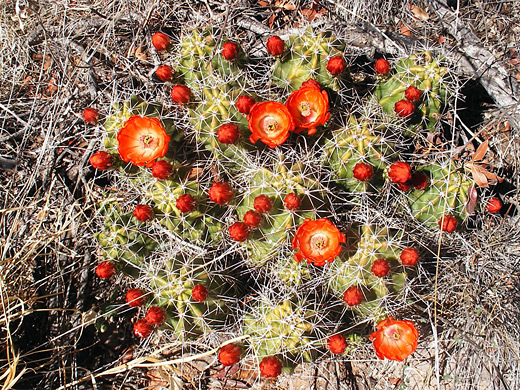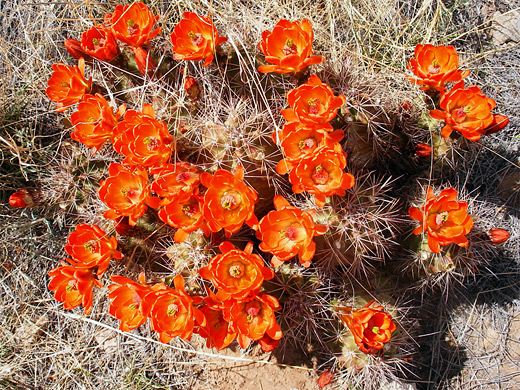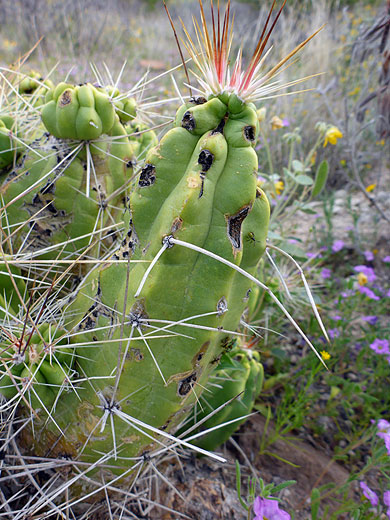Scientific name:
Echinocereus coccineus
Common name:
Scarlet hedgehog cactus, claret cup cactus, scarlet beehive cactus
Range:
South Arizona, most of New Mexico, a small part of south Colorado, the Big Bend area of west Texas, and west towards San Angelo
Form:
Low clusters, sometimes of 100 or more stems
Habitat:
Grasslands, scrubland, pinyon-juniper forest; often in partly shaded locations, up to 5,000 feet elevation. Volcanic soils are favored
Flowers:
Usually purplish red to orange, occasionally pink, blooming in April and May

Distribution map for echinocereus coccineus
Echinocereus coccineus is a variant of the more widespread, generally larger but otherwise very similar echinocereus triglochidiatus, characterised by sprawling clusters, bright red/orange flowers with green stigmas and rounded petals, low to medium spine cover and somewhat flabby stems. Clumps may have well over 100 members, and cover an area of several square feet.
These two echinocereus species can only definitively be identified by analysing their chromosomes, though the location is a guide as the ranges are largely separate, overlapping only in northern New Mexico, a small area of southern Colorado, and northwest Arizona. Also, coccineus plants tend to have more spines, more areoles and more ribs, while spines are more likely to be circular in cross-section rather than oval.
Stems of echinocereus coccineus are up to 15 inches tall and 6 inches across. There are usually between five and 19 spines per areole, often darker at the tip - up to 13 radials, and from zero to six centrals, these up to 3 inches long. Flowers, up to 3 inches in diamater, have red, orange-red or purplish-red tepals (occasionally pink), pale greenish-yellow filaments, purple anthers and green stigma lobes.
There are several regional varieties of echinocereus coccineus, distinguished by differences in spine number and length, but no named variants. Plants prefer partly shaded locations and are often obscured by twigs or long grass, though they become very visible when blooming in the spring.
These two echinocereus species can only definitively be identified by analysing their chromosomes, though the location is a guide as the ranges are largely separate, overlapping only in northern New Mexico, a small area of southern Colorado, and northwest Arizona. Also, coccineus plants tend to have more spines, more areoles and more ribs, while spines are more likely to be circular in cross-section rather than oval.
Stems of echinocereus coccineus are up to 15 inches tall and 6 inches across. There are usually between five and 19 spines per areole, often darker at the tip - up to 13 radials, and from zero to six centrals, these up to 3 inches long. Flowers, up to 3 inches in diamater, have red, orange-red or purplish-red tepals (occasionally pink), pale greenish-yellow filaments, purple anthers and green stigma lobes.
There are several regional varieties of echinocereus coccineus, distinguished by differences in spine number and length, but no named variants. Plants prefer partly shaded locations and are often obscured by twigs or long grass, though they become very visible when blooming in the spring.
All Contents © Copyright The American Southwest | Comments and Questions | Contribute | Affiliate Marketing Disclosure | Site Map



















